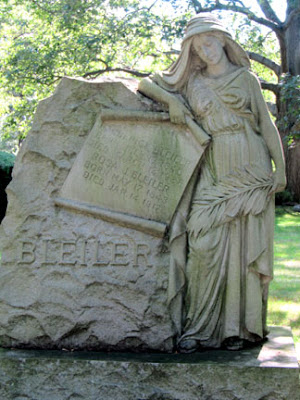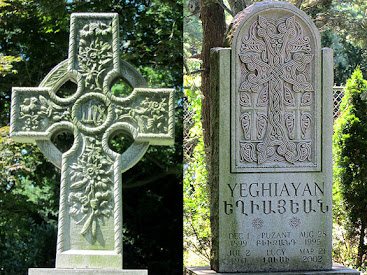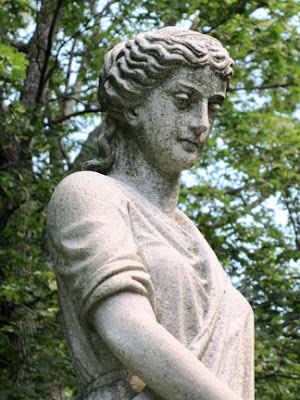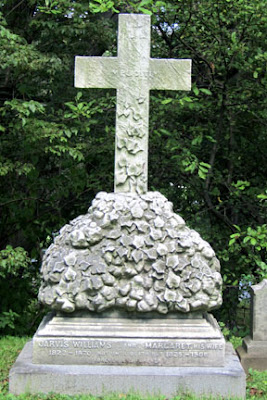Designated a National Historic Landmark, this 175 acre cemetery was founded in 1832. The Egyptian Revival Gateway designed by Dr. Jacob Bigelow:
The Story Chapel also servers as a Visitors Center and Museum:
This cemetery had more maintenance/grounds-keepers and security staff than all others put together…there was a lot of activity, including a funeral. According to their publications, “Mount Auburn Cemetery began the “rural” cemetery movement out of which grew America’s public parks.”
I have been to a lot of cemeteries; sometimes a historic one might have a map at the entrance however this one not only had maps, it had several pamphlets (for a price) including a listing of big trees, flowers, bird sightings, grave sites of Notables and historical information.
Two views of an interesting modern headstone:
There were several markers with wheat sheaves, an emblem of the divine harvest.
A 1997 tree inventory recorded over 5,300 trees, some over three feet in diameter, predating the founding of the cemetery. “Other trees are specimens of rare size and maturity for their species. The collection of trees includes more than 610 taxa, making the Cemetery an arboretum of national importance.” This tree caught my eye, it looks very different from different angles:
Fern-Leaf Beech (Fagus sylvatica ‘Asplenifolia’) planted in 1890, its’ trunk is 32 inches and the height is 48 feet. How sad, people over the years, have disfigured it’s beauty.
This look like a face:
Now it looks like someone mooning:
This big hole reminds me of my childhood. Out side our farm house there was a very large oak tree with a hole like this. As kids, we were always throwing things into it, envisioning it as a bottomless pit, which it seemed to be.
There are several plots enclosed with fences…once more than 1700, long-term maintenance and changes in aesthetic taste led to removal of most of them. Only about sixty remain, which are given special attention and protective treatment.
How interesting…the image on the left is filled with flowers not a Celtic pattern, while the image on the right has a Celtic pattern but the writing looks Greek:
The final resting place of thousands of distinguished people; here, are a few I found. Francis Parkman, horticulturist, historian and author of The Oregon Trail: Sketches of Prairie and Rocky-Mountain Life.
Clara Endicott Sears, writer, historian, preservationist, philanthropist, she founded the Fruitlands Museum (Harvard, MA).
Dorothea Dix, about her it has been said, “There are few cases in history where a social movement of such proportions can be attributed to the work of a single individual” (Kovach, 1972). A social activist, who reformed the treatment of the mentally ill, she also served as the Superintendent of Army Nurses during the Civil War.
Mary Baker Eddy, founder of the Christian Science religion and the Church of Christ, Scientist in Boston, MA.
Oliver Wendell Holmes, an important medical reformer, he was a physician, professor, lecturer and an author... considered by his peers as one of the best writers of the 19th century.
Henry Wadsworth Longfellow, national literary figure, linguist, educator, poet, he was a world-famous personality by the time of his death.
Bigelow Chapel, a Gothic Revival chapel also designed by Dr. Jacob Bigelow:
The Sphinx. Commissioned by Dr. Jacob Bigelow after the Civil War to commemorate the preservation of the Union and destruction of African slavery, the Sphinx combines “the strength of the lion with the beauty and benignity of woman.” Acting on Bigelow’s instruction, the sculptor Martin Milmore added an American eagle to the forehead and an American water lily to the base.
Bigelow Sphinx
























































































